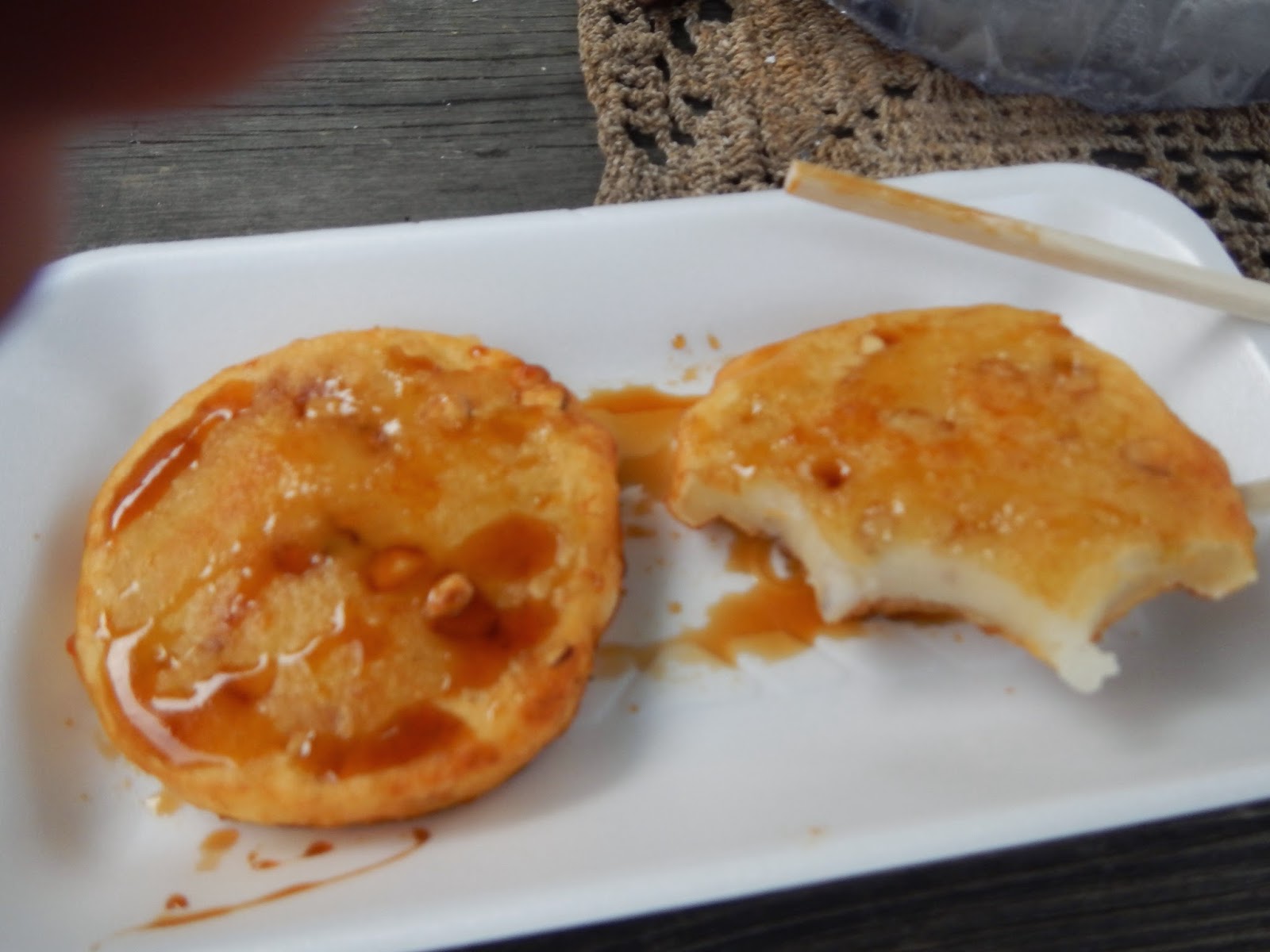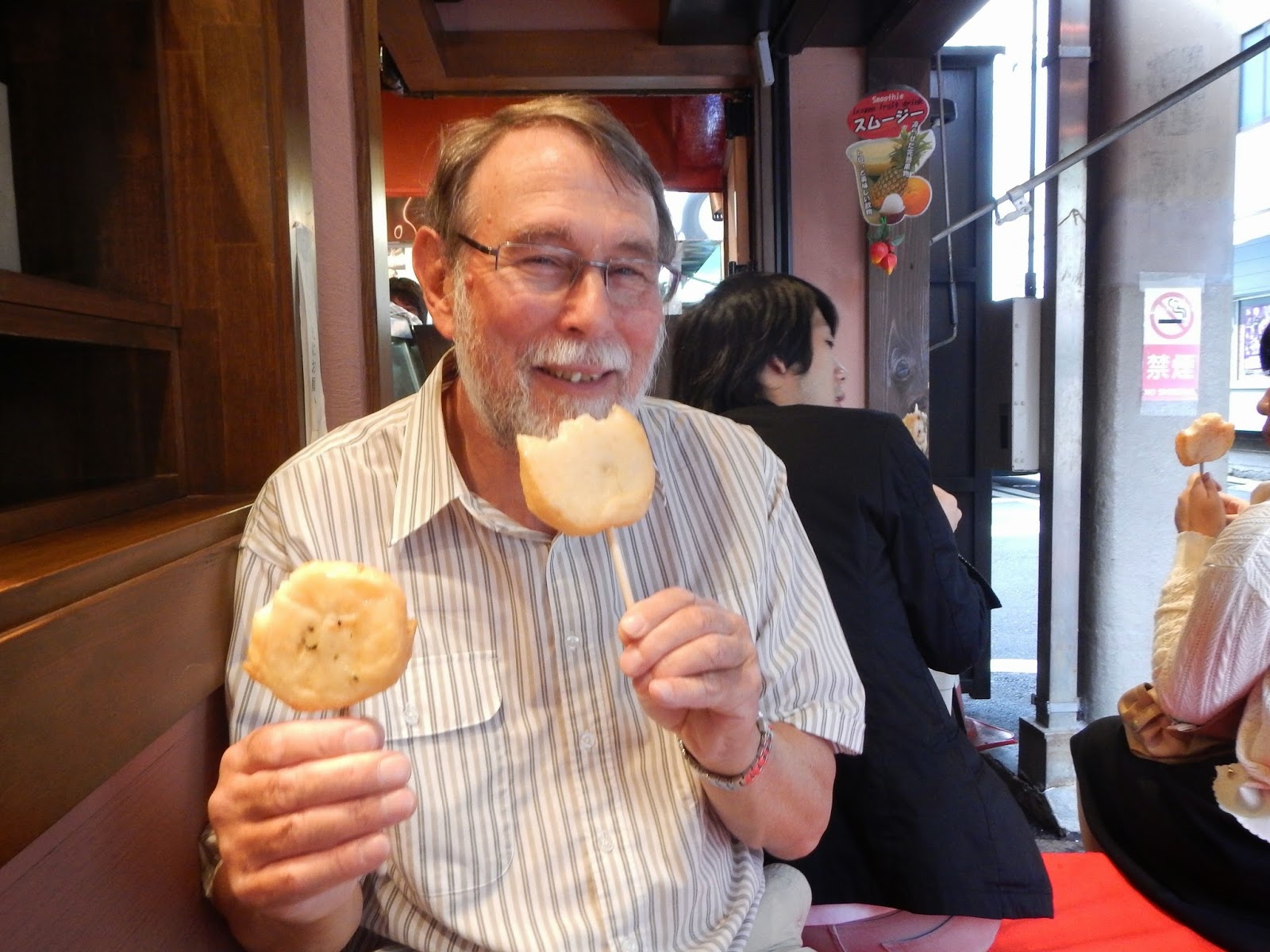We wondered whether Hokkaido is to the rest of Japan as Newfoundland is to Canada, or Tasmania is to the rest of Australia: a bit off the end and sometimes the butt of jokes, but it was too difficult a question for our Japanese contacts. However there was no doubt when we arrived in Kyoto that we had come both to a bigger city and one which has a long, long history.
We flew from Sapporo to Osaka and took a 50 minute coach ride from Osaka airport to Kyoto station, then a short cab ride to the Kyoto Tokyu hotel, which is almost next door to the huge Nishi Hongan-ji temple, and a ten minute walk to the nearest subway station, or twenty minutes back to the main railway station. The hotel was clean and comfortable, and gave us a good base, though it would have been nice to be closer to eating places,
Kyoto railway station almost deserves a blog post to itself. It's a huge, airy steel and concrete structure that rises eleven stories above the railway itself with an internal atrium from top to bottom and long flights of escalators to carry you up and down. It incorporates department stores, a couple of performance spaces and two food courts (one on the eleventh floor, the other underground) where we ate each night. Bustling crowds whenever we were there, traveling, eating, shopping or watching the light show created by hundreds of computer-controlled lights on the risers of the wide flights of steps from levels five to eleven.
Kyoto Station. The trains are hidden somewhere down below.
Kyoto Station by night. Note the light show at the far end. We watched the blood moon from the roof garden.
Getting around in Kyoto was a little bit more complicated than in Sapporo. There is a subway, like Sapporo with two lines that cross more or less at right angles, but it only serves part of the conurbation, and doesn't really get you to the foothills to the east and west where most of the temples and gardens are. Several railway lines increase the coverage, or you could try the bus, but I never quite feel in control when taking the bus in strange places; something that doesn't run on rails seems less determinate, as if the driver might suddenly decide to whisk you off to somewhere that's not on the map. So we stuck to the certainty of the subway and the railway.
Even in downtown Kyoto there is a nice mixture of old and new, so behind the biggest Daimaru department store is the Nishiki arcade market with a long series of stalls selling vegetables, fish, tea, ice cream, ceramics, etc etc. The arcade ends at a small temple and side streets on both sides had older houses, and overhead a spider's web of power cables. Why, in tidy and efficient Japan, all these cables are above ground I don't know. Perhaps it's something to do with earthquakes.
Nishiki Market, downtown Kyoto.
Downtown Kyoto side street. Is that wiring safe?
In the foothills to the west and east of the city are the temples and gardens that were established when Kyoto was Japan's capital. Some date back to the 11th and 12th centuries, though many are a bit grandfather's axe-ish, as fire is a constant threat to these wooden buildings. The scale of some of them is huge, amongst the largest wooden buildings in the world, and they have a wonderful solidity thanks to the immense timbers used to construct them. We were more attracted to the gardens than the temples
per se, but we took off our shoes to visit a couple, trying to understand what they mean to Buddhist/Taoist worshippers. At Nishi Hongan-ji we met some of the Chinese visitors who were staying at our hotel just up the street, all wearing white aprons and sashes, on their hands and knees rubbing the bamboo mats in one of the two great halls. Nothing very solemn about it, lots of chat and laughter, but apparently some sort of ritual for pilgrims to this, the headquarters of a particular Buddhist movement. In the next door great hall a much more solemn "confirmation" ceremony was going on, where people seemed to be committing (or re-committing) themselves, each one with someone senior to convey them to the front.
Nishi Hongan-ji. Not even the main gate.
Nishi Hongan-ji. Quiet corner round the back somewhere.
Nishi Hongan-ji. Chinese pilgrims (?) cheerfully polishing the floor.
We took the train out to the Arashiyama district to the west, and before joining the tourists on the temple-rich eastern side of the river we walked up the opposite bank through thick forest. We saw signs to the Senko-ji Zen temple (1641) that promised a good view of the city, so we climbed the hill and paid our ¥400 to the monk so that we could visit the reception hall and view the Buddha in the little main hall. Unlike the bigger and more frequently visited temples there was some proselytising here, with hand-written notices encouraging us to be in the moment, and listing Gandhi's seven social sins (nothing to disagree with there).
Arashiyama river.
Buddhist monk at Senko-ji temple.
Bell at Senko-ji. I wished I had rung it; there was a limit of three rings per person.
Back across the river we visited Tenryui-ji and our first Japanese garden, one that is listed on the World Heritage register. Even at the end of summer when you might expect things to be a bit tired almost every vista in the garden was a picture. All so carefully managed and manicured; no tree or bush in a Japanese garden is simply allowed to do its own thing! And as in the railway station where the smallest scrap of litter is picked up within seconds, here there were quiet gardeners discretely picking up the fallen leaves, trimming the bushes by hand and keeping everything in order.
Tenryui-ji gardens. World Heritage for sure.
Tenryui-ji gardens. Every vista a picture.
On through the Arashiyama bamboo grove with its hypnotic stems fading into the distance, and up narrow streets in a rather well-to-do area to Gio-ji, a small temple with a beautiful moss garden cool and green under the trees, looking so natural but entirely contrived, like all the gardens.
Bamboo grove, Arashiyama.
Narrow streets in Arashiyama, but still used by cabs!
Gio-ji moss garden.
As an antidote to temples and gardens we went to the Kyoto Aquarium, not far from the station. What I mostly wanted to see was the Japanese Giant Salamander, a newt that's well on the way to being a crocodile. The aquarium is quite new, and they obviously have their priorities right, because right inside the door was a fine display of local river fauna with several salamanders! A most impressive amphibian, though they win no points for beauty. After that the rest of the aquarium had a lot to live up to, but it was well done, with a huge ocean tank, dolphins and a range of smaller displays, including a rather sad-looking Tasmanian Giant Crab. I was pleased to see some giant deep sea slaters (
Bathynomus sp.) on display, but I was quite overwhelmed when in the aquarium shop, along with dozens of giant salamander soft toys, I saw life-sized, soft toy giant slaters! Invertebrate soft toys: there should be more of them. I just had to bring one home.
Giant salamander, Kyoto Aquarium. No points in the beauty contest.
What's the collective noun for giant salamanders?
An unusual pair of soft toys.
And why not?? (He said, defensively).
We had another day with the temples on the western side of the city in the Higashiyama district. First Nanzen-ji a fine temple with a huge sanmon gate. It also has a zen garden, but the effect was slightly spoiled by the man in chest waders retrieving a tree that had disrespectfully fallen into the little lake. Eikan-do was perhaps our favourite temple, the combination of a pagoda with a view across the city, the grand temple hall with the "Buddha Glancing Backwards" and beautiful gardens. We walked on a little way on the "Philosopher's Path", a granite-paved path beside a small canal that would be covered in cherry blossom in the spring and named after a 20th century philosopher who was supposed to stroll the path "lost in thought".
Nanzen-ji, sanmon gate.
Water for ceremonial washing.
Water sometimes delivered in spectacular fashion.
Autumn colours, Eikan-do.
The Philosopher's Path. How often did he fall in?
Temple in Gion. Pulling the ropes rings the bell. Clap three times and pray.
Geisha in Gion district (she was posing).
Our final encounter with Kyoto's history was at Nijo-jo, the castle built for the shogun in 1603. It has moats and massive granite walls surrounding it, and the wooden building was carefully arranged to show the superiority of the shogun over his guests, by subtle differences in floor and wall heights. And the "nightingale" floors were all carefully engineered with nails and wedges to squeak at the least pressure, and so give warning of potential assassins sneaking around at night. Nearby is the present day imperial palace, a relatively recent building, but in a huge public park that gave us a shady refuge for lunch after we had visited the textile district close by and seen silk being wound off silkworm cocoons.
Nijo-jo castle. The outer moat and walls.
School group, outside the main gate of Nijo-jo. Yellow caps off for the photo. Note smaller, private school group to the right.
Nijo-jo main gate, detail.
Main building, Nijo-jo. No photos inside!
Nijo-jo, inner moat and walls. The building was well-protected!
Venerable muku tree, outside the Imperial Palace, Kyoto.
We had only a few contacts with Japanese people beyond Take, our birding guide, hotel and public transport staff. Another school group bailed us up in Kyoto and asked where we were from in perfect english, but I must record the gentleman who stopped to talk on the subway platform, laboriously checking his hand-written phrasebook to ask where we were from. He went off in the elevator, and then re-appeared a few moments later to sing us a few bars of Waltzing Matilda, "your national song"! I can only recall one person (a lady in the noodle shop in Sapporo who must have been having a bad day) who wasn't scrupulously polite and helpful.
The shinkansen bullet train took us from Kyoto to Tokyo in about three hours. I suppose we could have flown directly to Narita, but I couldn't miss the opportunity to ride on such an iconic train. And it is fifty years since the first bullet train! I had imagined that it was some sort of special service, but in fact they shinkansen trains were leaving Kyoto at about 15 minute intervals and with the number that we passed in the opposite direction there must be a huge number on the track at any given moment. Very fast, comfortable and smooth, even though our JR pass was only good for the second tier of shinkansen services.
Bullet train coming, ooooh!
And that's travel: bullet train at 200kph, or just standing, waiting.
And so ended our three weeks in Japan. I'll try to cover the food and some other observations in a final post.





























































